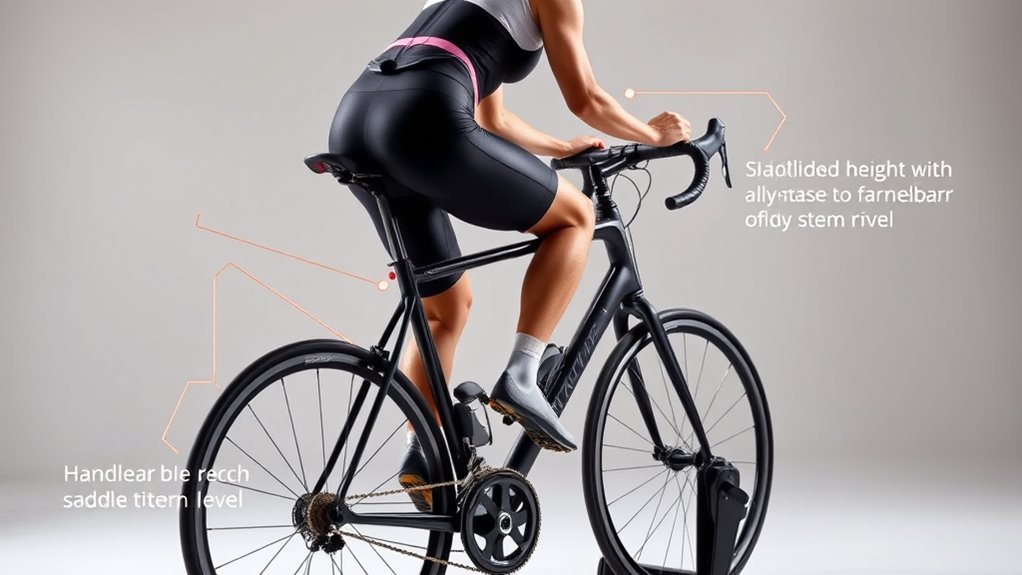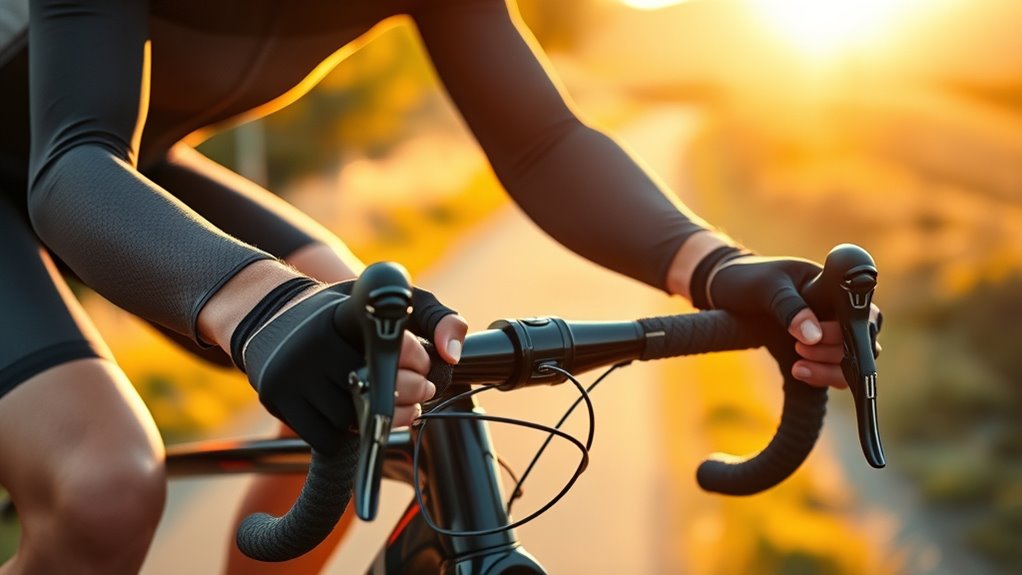To achieve comfort and power on your bike, start by adjusting your saddle height so that when you sit, your heel is on the pedal at its lowest point, ensuring your leg is fully extended with a slight bend. Then, set the handlebar reach so your elbows are slightly bent and your grip feels relaxed, promoting a neutral spine. Properly balancing these settings reduces strain and optimizes efficiency—keep going to discover how fine-tuning your fit boosts your ride.
Key Takeaways
- Adjust saddle height so your heel is on the pedal at the lowest point with a slight knee bend.
- Set handlebar reach to keep elbows slightly bent and maintain a relaxed, comfortable grip.
- Ensure saddle and handlebar positions promote an upright posture for better comfort and power transfer.
- Regularly fine-tune saddle height and handlebar reach based on riding comfort and performance feedback.
- Proper bike fit reduces strain, prevents injury, and enhances efficiency during both short and long rides.

First, focus on saddle height. This is the distance from the saddle to the pedals. If it’s too high, you’ll find yourself overextending your leg at the bottom of the pedal stroke, which can lead to knee pain and a feeling of instability. On the other hand, if the saddle is too low, you won’t generate enough power, and you may experience discomfort in your hips or thighs. To find the right saddle height, sit on your bike and place your heel on the pedal. When the pedal is at the lowest point, your leg should be fully extended with a slight bend in the knee. This position ensures you’re neither overextending nor underusing your muscles, allowing for ideal power transfer and reduced strain. Additionally, proper saddle height can influence your overall bike stability, making your ride safer and more efficient.
Next, consider handlebar reach. This is the distance from your saddle to the handlebars, directly affecting your riding posture. If the reach is too long, you’ll feel stretched out, which can strain your neck, shoulders, and lower back. If it’s too short, you might feel cramped and lose control or stability. To adjust handlebar reach, sit on your saddle and lightly hold the bars. Your elbows should be slightly bent, and you should be able to reach the handlebars comfortably without feeling overstretched or compressed. Proper handlebar reach promotes a neutral spine position, reducing fatigue and discomfort on longer rides.
Frequently Asked Questions
How Often Should I Get a Professional Bike Fit?
You should get a professional bike fit every 6 to 12 months or whenever you notice discomfort, pain, or changes in your riding. Regular bike fit maintenance guarantees ideal comfort and power, preventing injuries. Your professional fit frequency depends on your riding habits, body changes, and bike use. If you’re experiencing issues or have made significant bike adjustments, scheduling a professional fit sooner can help maintain peak performance.
Can a Bike Fit Improve My Cycling Injury Recovery?
A stitch in time saves nine, and a proper bike fit can definitely assist your injury recovery. By optimizing your ergonomic positioning, a professional fit helps reduce strain and prevent future injuries, speeding up healing. It also ensures you’re not overusing certain muscles, which is key to injury prevention. Adjusting your bike now supports your recovery, making cycling safer and more comfortable as you regain strength.
What Adjustments Are Needed for Different Cycling Disciplines?
You need to adjust saddle height and handlebar reach for different cycling disciplines. For road cycling, set a higher saddle for efficiency, and bring the handlebars closer for better aerodynamics. Mountain biking requires a lower saddle for control, with handlebars positioned for maneuverability. For triathlons, prioritize a forward saddle position and extended handlebar reach to optimize aerodynamics and comfort over long distances. Always fine-tune based on your body and riding style.
How Do I Maintain My Bike Fit Over Time?
Think of your bike fit as a garden needing regular tending. To maintain it, you should regularly check your cycling posture and saddle height adjustment, especially after long rides or changes in fitness. Keep an eye out for discomfort or numbness, which signals it’s time for a tweak. Consistent adjustments ensure your position stays ideal, preventing strain and maximizing comfort and power on every ride.
Does Bike Fit Affect My Bike’s Aerodynamics?
Yes, your bike fit impacts aerodynamics by influencing your aerodynamic positioning. When you adjust your saddle height, handlebar reach, and tilt, you can reduce wind resistance and improve speed. Frame geometry plays a key role too; a more aggressive geometry positions you lower and forward, cutting through the air more efficiently. Proper fit guarantees you stay comfortable while optimizing these aerodynamic benefits, making your ride faster and less tiring.
Conclusion
Getting your bike fit right not only boosts your comfort but also enhances your power on every ride. Did you know that an improper fit can reduce pedaling efficiency by up to 10%? By paying attention to these basics, you can prevent discomfort and injury while riding longer and stronger. Remember, a properly fitted bike makes every mile more enjoyable. So, take the time to fine-tune your setup—you’ll ride better and feel great doing it.








